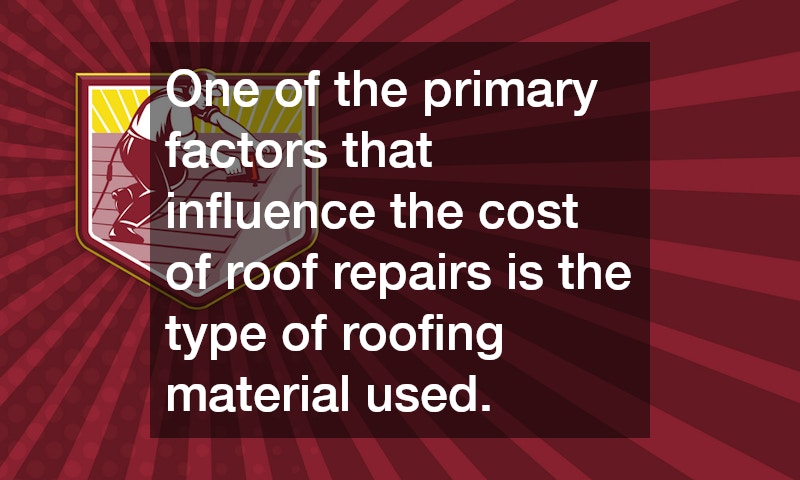

When it comes to maintaining your home, one of the most critical aspects is ensuring that your roof is in good condition. Roof repairs can range from minor patches to major overhauls, and the costs can vary widely. Understanding the factors that affect the cost of roof repair can help you make informed decisions and better prepare for any expenses.
1. Type of Roofing Material
One of the primary factors that influence the cost of roof repairs is the type of roofing material used. Different materials require different repair techniques and come with varying levels of durability, which can affect both the short-term and long-term costs. For instance, asphalt shingles are generally cheaper to repair compared to slate or tile, which need specialized skills and equipment to handle.
Asphalt shingles, being the most common roofing material, are relatively easy and cost-effective to repair. However, they might not last as long as metal or tile roofs, which can hold up better in harsh weather but require more expensive repairs when damaged. It’s essential to consider the type of material on your roof when estimating repair costs, as this will significantly influence the price.
Additionally, newer and eco-friendly materials might come at a higher upfront cost but could offer savings in energy efficiency and longevity. It’s crucial to weigh the immediate repair costs against potential future savings when choosing the type of roofing material for your home. This decision will impact not only the repair budget but also the overall value and durability of your property.
2. Extent of Roof Damage
The extent of damage your roof has sustained is another critical factor in determining the repair cost. Minor issues like missing shingles or small leaks can be addressed quickly and at a lower expense. However, significant damage such as widespread water damage, structural issues, or mold growth can lead to considerably higher costs due to the complexity and scope of repairs needed.
When assessing your roof for damage, it’s important to conduct a thorough inspection to identify all potential issues. Sometimes, what appears to be a minor issue can be indicative of underlying problems that might require extensive work. Addressing such issues promptly can prevent further damage and lead to more cost-effective solutions.
Larger areas of damage might require partial or full roof replacement, which significantly increases costs. Furthermore, if the structural integrity of the roof is compromised, additional work such as reinforcing beams or replacing the underlying sheathing might be necessary. Regular maintenance and prompt repairs can help mitigate severe damage, ultimately reducing overall repair expenses.
3. Labor and Geographical Location
The cost of labor is another significant factor affecting roof repair expenses. Depending on your location, labor costs can vary widely due to differences in local economies and the availability of skilled workers. In areas with a high cost of living, labor expenses tend to be higher, which will impact the total repair cost of your roof.
Additionally, the demand for roofing services can influence labor costs. During certain seasons or after severe weather events, the demand for repair services might increase, leading to higher prices due to limited availability of contractors. Planning your repairs during off-peak times can potentially lead to savings, as contractors may offer better rates when business is slower.
It’s also important to consider the reputation and experience of the contractor you choose. Although hiring an experienced professional might come at a higher rate, it can ultimately be cost-effective due to quality workmanship and efficient repairs. Selecting the right contractor plays a significant role in ensuring the durability and success of your roof repair project.
4. Roof Accessibility and Complexity
The accessibility and complexity of your roof also contribute to the overall cost of repairs. Roofs with easy access and simple designs are generally quicker and less expensive to repair compared to those with steep pitches or complex architectural features. If scaffolding or special equipment is needed to safely access your roof, these additional requirements can increase labor costs.
Complex roof designs with multiple levels, skylights, or dormers require more time and expertise to repair. The presence of such features can complicate the repair process, necessitating specialized attention to ensure integrity and prevent leaks. It’s vital to factor these complexities into your cost estimates when planning roof repairs.
Accessibility issues can impact not just the labor costs but also the time required to complete repairs. Projects with greater complexity typically involve more intricate work, leading to longer completion times and potentially higher expenses. Therefore, understanding your roof’s particular design and accessibility challenges is crucial in accurately projecting repair costs.
In conclusion, various factors impact the cost of roof repairs, from the type of roofing material to labor and geographical considerations. By gaining an understanding of these factors, homeowners can better prepare and budget for roof-related expenses. Being informed enables you to make strategic choices about your roof repairs and protects your home investment long-term.



